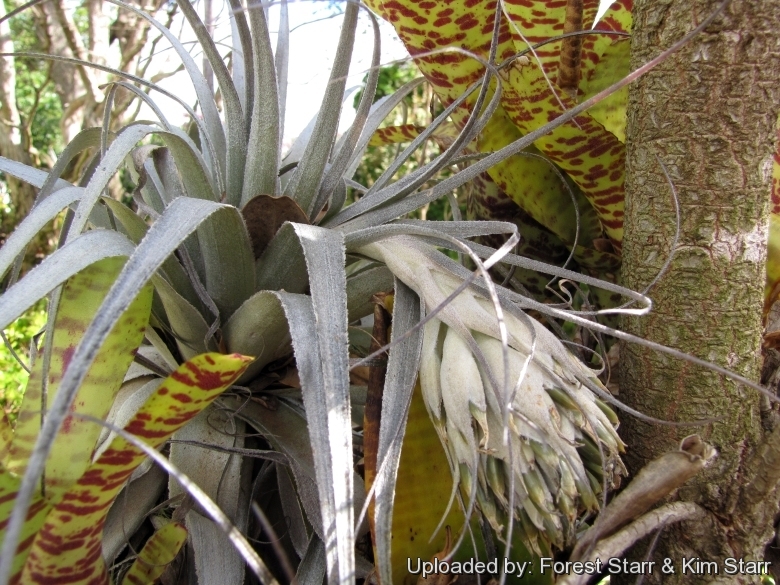
Habit with fruit stalk at Enchanting Floral Gardens of Kula, Maui, Hawaii (USA). March 12, 2012.
Origin and Habitat: Tillandsia gardneriSN|28157]]SN|28157]] has a wide geographical distribution comprising Venezuela, Colombia, Brazil (as far south as Rio Grande do Sul), and Trinidad & Tobago.
Altitude: From near sea level to 1600 metres above sea level.
Habitat: Tillandsia gardneriSN|28157]]SN|28157]] grows as an epiphite on trees and other plants in tropical dry areas but will grow on almost anything. The arched, folded leaves act as collectors for dew or mist. After condensing, the water trickles to the base of the stem, where it is absorbed. This method is so efficient that the plant needs almost no root system. When the plants have roots, they use them to hold on to a perch. Moisture and nourishment enter through the scales on the leaves. Due to its hight ornamental value and low multiplication rate and slow growth this species led to illegal over-collection in the wild to meet commercial demands.
Synonyms:
See all synonyms of Tillandsia gardneri
back
Accepted name in llifle Database:Tillandsia gardneri Lindl.Edwards's Bot. Reg. 28: t. 63 (1842)Synonymy: 10
back
Common Names include:
ENGLISH: Air plant
Description: Tillandsia gardneriSN|28157]]SN|28157]] is an epiphytic perennial species with pretty silvery leaves.
Stem: Stemless.
Rosette: Small, only 12-25 cm high and wide, with numerous leaves.
Leaves: 10-27 cm long, triangular to filiform acuminate, without distinction between sheath and blade, 15-20 mm wide, silvery grey or grey-blue, flexible, lepidote soft and velvety.
Flowers: Each plant produces 4-12 scapes (inflorescences) also silvery, suberect to decurved and slender, each of which bears 3 to 12 slender, funnel-shaped flowers. The flowers are rosy-red to pale lavender-pink with 3 sepals and 3 petals, with spreading terminal lobes and green-pink floral bracts.
Bloomtime Range: Mainly from Late Spring to Late Summer.
Bibliography: Major references and further lectures
1) Forest & Kim Starr “Tillandsia gardneri (Tillandsia)”. Plants of Hawaii. <http://www.starrenvironmental.com>. Downloaded on 20 August 2014.
3) Wikipedia contributors. "Tillandsia gardneri." Wikipedia, The Free Encyclopedia. Wikipedia, The Free Encyclopedia, 6 Jul. 2014. Web. 18 Sep. 2014.
3) David H. Benzing “Bromeliaceae: Profile of an Adaptive Radiation” Cambridge University Press, 06/Apr/2000
4) Paul T. Isley “Tillandsia: the world's most unusual air plants” Volume 1 Botanical Press, 1987
5) Ulrich Baensch, Ursula Baensch "Blooming bromeliads" Tropic Beauty Publishers, 1994
6) Smith, L.B. & R. J. Downs. "Tillandsioideae (Bromeliaceae)" Part II. Flora Neotropica, Monograph 14(2): 663–1492 1977.
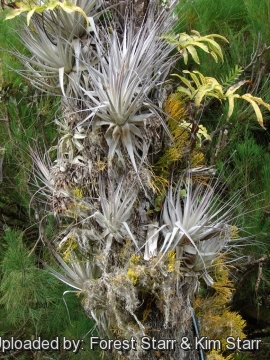 Reproducing and habit on hapuu at Enchanting Floral Gardens of Kula, Maui, Hawaii (USA). April 30, 2009. Photo by: Forest Starr & Kim Starr
Reproducing and habit on hapuu at Enchanting Floral Gardens of Kula, Maui, Hawaii (USA). April 30, 2009. Photo by: Forest Starr & Kim Starr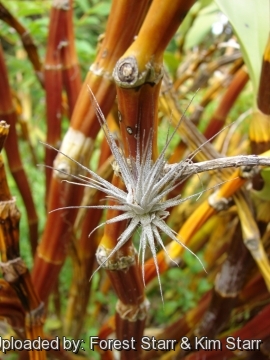 Naturalized plant from nearby at Enchanting Floral Gardens of Kula, Maui, Hawaii (USA). April 30, 2009. Photo by: Forest Starr & Kim Starr
Naturalized plant from nearby at Enchanting Floral Gardens of Kula, Maui, Hawaii (USA). April 30, 2009. Photo by: Forest Starr & Kim Starr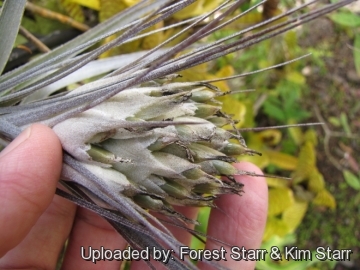 Flower stalk at Enchanting Floral Gardens of Kula, Maui, Hawaii (USA). March 12, 2012. Photo by: Forest Starr & Kim Starr
Flower stalk at Enchanting Floral Gardens of Kula, Maui, Hawaii (USA). March 12, 2012. Photo by: Forest Starr & Kim Starr Tillandsia gardneri Photo by: Luiza Ferreira
Tillandsia gardneri Photo by: Luiza Ferreira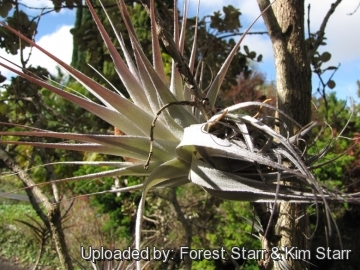 Habit at Enchanting Floral Gardens of Kula, Maui, Hawaii (USA). March 12, 2012. Photo by: Forest Starr & Kim Starr
Habit at Enchanting Floral Gardens of Kula, Maui, Hawaii (USA). March 12, 2012. Photo by: Forest Starr & Kim Starr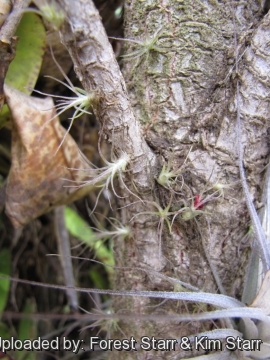 Seedlings on ohia at Enchanting Floral Gardens of Kula, Maui, Hawaii (USA). March 12, 2012. Photo by: Forest Starr & Kim Starr
Seedlings on ohia at Enchanting Floral Gardens of Kula, Maui, Hawaii (USA). March 12, 2012. Photo by: Forest Starr & Kim Starr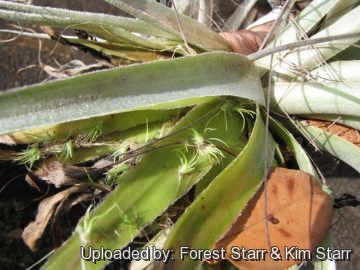 Seedlings at Enchanting Floral Gardens of Kula, Maui, Hawaii (USA). March 01, 2012. Photo by: Forest Starr & Kim Starr
Seedlings at Enchanting Floral Gardens of Kula, Maui, Hawaii (USA). March 01, 2012. Photo by: Forest Starr & Kim Starr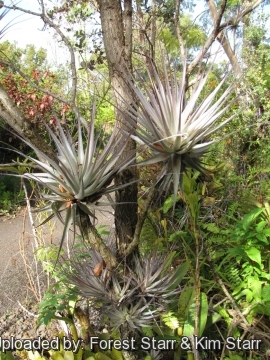 Habit on ohia at Enchanting Floral Gardens of Kula, Maui, Hawaii (USA). March 01, 2012. Photo by: Forest Starr & Kim Starr
Habit on ohia at Enchanting Floral Gardens of Kula, Maui, Hawaii (USA). March 01, 2012. Photo by: Forest Starr & Kim StarrCultivation and Propagation: Grow Tillandsia in a well ventilated place mounted on wood or grown bare root. They can also be grown on slabs of bark or tree fern fibre. Allow medium to dry out between waterings.
Moisture: From mid spring through fall, mist daily and once a month, mist with 1/4 strength water soluble fertilizer. Keep crown filled with distilled water. If grown outdoors, keep dry during winter.
Exposure: This plant likes bright indirect light and it is best placed in a sheltered spot in the garden during the summer to facilitate flowering. Dappled to Full Sun
Hardiness: USDA Hardiness Zone 9 to 11. These curious plants may be grown outdoors as long as temperatures do not drop below 5° degrees Celsius.
pH Range: 5.5 to 7.5.
Propagation: Division or seed. The primary plant tends to die off after flowering, but will be replaced by the offshoots. Plants can be divided at any time of the year. Seeds are germinated on peat moss. Seeds need light to germinate.

















